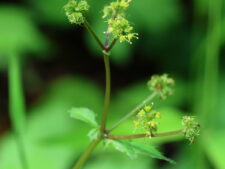
Description
This native perennial grows up to 2 feet tall. The erect stems are reddish-purple at their base and at the leaf axils. Leaves are divided into 3-5 deeply cut and toothed leaflets which surround the stem (A,B). The tiny, greenish-yellow flowers form globular heads on long stalks (C,D). The fruits are oval and covered with hooked bristles (F). See comments for comparison with similar Canadian Black Snakeroot.
Found in upland and lowland woods, flowering in May and June. This species (S. odorata) is common in Fontenelle Forest, but significantly less so at Neale Woods where most plants are Canadian Black Snakeroot (S. canadensis).
The Black Snakeroots (Sanicula) are easily recognized by their clusters of bur-like seed heads with curved bristles and compound leaves divided into 3 or 5 palmate leaflets. Separation of our 2 closely related species is fairly easy when flowering; Clustered Black Snakeroot (S. odorata) has greenish-yellow flowers while those of Canadian Black Snakeroot (S. canadensis) are greenish-white. Flowerheads of Clustered Snakeroot also have more flowers. Also helpful, although too small to be a good field mark, are its long curved pistils which project well above the flower. (as in photos E and F). When not in flower they cannot be reliably separated.
Disclaimer: The content of NatureSearch is provided by dedicated volunteer Naturalists of Fontenelle Forest who strive to provide the most accurate information available. Contributors of the images retain their copyrights. The point of contact for this page is: Roland Barth.

 Identification
Identification



